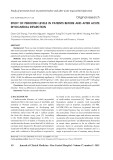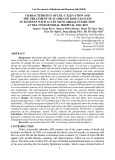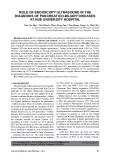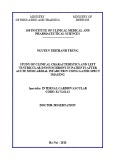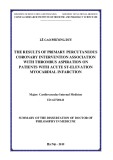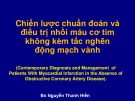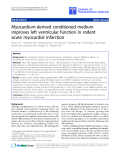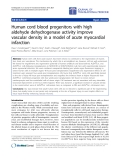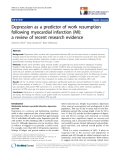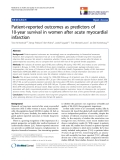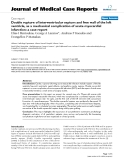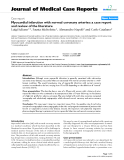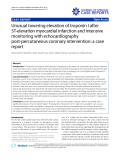
Journal of Medicine and Pharmacy - No.5 17
ROLE OF ENDOSCOPY ULTRASOUND IN THE
DIAGNOSIS OF PANCREATICO-BILIARY DISEASES
AT HUE UNIVERSITY HOSPITAL
Tran Van Huy1, Vinh Khanh2, Phan Trung Nam2, Tran Quang Trung2, Le Minh Tan2
(1) Internal Department – Hue University of Medicine and Pharmacy, Vietnam
(2) Gastrointestinal Endoscopic Center, Hue University Hospital, Vietnam
Background and aim: To evaluate the efficacy of endoscopy ultrasound for diagnosis of the diseases
of pancreatico-biliary system. Patients and methods: A cross - sectional study was conducted on 78
patients undergoing endoscopy ultrasound to diagnose pancreatico-biliary diseases. Results: Study on a
total 78 patients who have been hospitalized at the Gastrointestinal Endoscopic Center – Hue University
Hospital. EUS has been used to diagnose pancreatico – biliary in the period from 5/2013 to 7/2014.
We have some following results: (i) The age of patients is from: 22 to 80, medium age is 49 ± 19. The
percentage of the lesions at biliary duct is 49.5%, pancreatic diseases comprise of 40% and gall-bladder
diseases make up 10.5%. Biliary and gall-bladder diseases: The lesion at gall-bladder: Gall-bladder
stones constitute 66.7%, gall-bladder tumor is 22.2% and polyp represents 11.1%; The lesion at biliary
system: Tumors at biliary comprise of 11.9%, bile duct stones make up 88.1% and stones located at
the proximal common bile duct represent 45.2%; Pancreatic diseases: The lesion of pancreas: Chronic
pancreatitis account for 67.2%, pancreatic stones make up 16.4%, pancreatic cyst constitute 12.3% and
pancreatic tumors represent 4.1%; EUS – FNA to diagnosis IPMN constitutes 66.7% and pancreatic
cancer makes up 33.3%. Conclusions: Endoscopic ultrasound is a highly effective method of diagnosis
for pancreatico-biliary diseases.
Key words: endoscopy ultrasound, diagnosis, pancreatico-biliary diseases.
1. BACKGROUND
The pancreatico-biliary diseases are very popular
in the Central Vietnam in general and Hue City in
particular. In the 1980s, Endoscopic Ultrasound
(EUS) was invented, and then rapidly EUS has
become a medium diagnosis in pancreatico – biliary
diseases. At present, in the Central Vietnam, EUS
is a highest medium in diagnosis for pancreatico
– billiary diseases. Most of scientific researches in
the world has demonstrated the specificity of EUS
in diagnosis for gastrointestinal and pancreatico –
billiary diseases [5], [7]. For pancreatico – billiary
diseases, EUS was proven to be a safe and accurate
technique in parenchyma and pancreas duct by
the scientific research of Akane Yamabe [21].
According to Chen’s research on 2673 patients,
EUS has the sensitivity at 94% and specificity at
95% in diagnosis of CBD stones, particularly EUS
has its distinctive strength in cases in which stone
is less than 5mm and located at head of pancreas
– common bile duct [4]. The study found that
detection of tumor of extra hepatic duct was superior
by EUS (94%) in comparison with CT-Scanner
(only 30%) and MRI (42%) [15]. Endoscopic
Ultrasound Fine Needle Aspiration (EUS-FNA)
was evaluated to have the highest specificity and
sensitivity in diagnosis and follow up pancreatico
– billiary diseases [22]. According to Mitsuhiro
Kida, EUS-FNA has specificity ranging from 76%
to 90% for pancreatic diseases [24]. This result
is also similar to Matsuyama’s research with the
specificity at 94.6% for malignant pancreas diseases
[11]. Therefore, it has an enormous significance in
development and completion of the EUS procedure
in Vietnam in general, as well as the Central
Vietnam and Western Highlands in particular. This
new medical procedure is highly practicable in the
pancreatico- billiary diagnosis in the early period.
In addition, the introduction of this new technique
will help to reduce the burden for medical demand
in the region.
Until now, there have not been any studies
and researches focusing on the effectiveness and
the accuracy of EUS in the Central Vietnam.
- Corresponding author: Tran Van Huy, email: bstranvanhuy@gmail.com
- Received: 8/5/2014 * Revised: 15/6/2014 * Accepted: 25/6/2014 DOI: 10.34071/jmp.2014.1e.3





